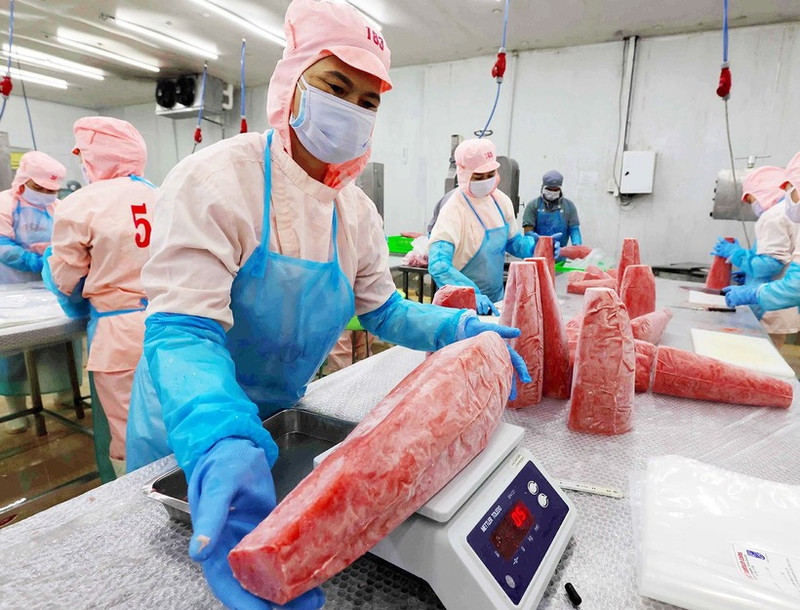US reciprocal tariff tests Vietnamese businesses
As of August 7, 2025, the US has officially imposed a 20% reciprocal tariff on many Vietnamese exports. It seems to have come as a shock, however, for entrepreneurs and experts, it is a turning point that could help Vietnamese enterprises strengthen their resilience, restructure their value chains, and gradually assert their position in the global marketplace.

Filling the gap left by major competitors
Seafood, especially shrimp and tuna, has long been a key export group of Viet Nam in the US market. In 2024, seafood export revenue to the US reached over 1.8 billion USD, accounting for around 20% of the total seafood export revenue of the country. In the first half of 2025, the figure reached nearly 850 million USD, up 12% year on year, demonstrating that the US market continues to be a key market.
The 20% tariff imposed on Viet Nam by the US should be viewed in comparative context. Indian shrimp faces tariffs as high as 25%, while Ecuador is at 15% but mainly on semi-processed shrimp. Viet Nam, by contrast, has strong advantages in deeply processed shrimp — a segment with higher added value and fewer direct competitors.
“If Vietnamese enterprises can take their advantage of deep processing, they will retain US customers and may even expand market share when some rivals face difficulties in tariffs or supply sources,” said Tran Van Linh, Chairman of the Board of Directors of Thuan Phuoc Seafood Company.
For tuna, although Ecuador currently benefits from a 15% tariff, Viet Nam can consolidate its position through diverse processing technology, with high quality canned and filleted products meeting international standards. Experts argue that in this period, intensifying national branding market and promoting premium processed products will be a ‘weapon’ for Viet Nam’s seafood industry to stand firmly.
The textile and garment sector, which accounts for around 15% of Viet Nam’s total export revenue, also faces the reciprocal tariff scope. Viet Nam is presently the second-largest apparel supplier to the US, after China. In the first six months of 2025, exports of textiles and garments to the US reached 9.2 billion USD, up 8.5% year on year.
Dramatically, China and India — two major competitors — are subject to higher tariffs than Viet Nam, creating considerable market space. According to Truong Van Cam, Vice President and Secretary-General of the Viet Nam Textile and Apparel Association, the structure of Viet Nam’s export items is quite similar to China’s, so we can fully compensate for part of the supply shortfall.
Bangladesh, which faces the same 20% tariff, enjoys cheaper labour, but Viet Nam holds advantages in quality, ability to fulfil large orders, and especially, delivery speed. If businesses quickly adopt green production, optimise costs, and invest in creative design, Viet Nam’s garment exports can maintain and even expand their US market share.
Additionally, redirecting a portion of orders to high-tech apparel products, while taking advantages of benefits from the Comprehensive and Progressive Agreement for Trans-Pacific Partnership (CPTPP) and the EU–Viet Nam Free Trade Agreement (EVFTA) to penetrate Europe and Canada, will help the textile sector reduce dependence on the US market and increase resilience to market fluctuations.
The new tariff policy affects not only consumer goods but also industries such as wood, electronics, and components. Economist Le Dang Doanh stated that this is the right moment for Viet Nam to upgrade its value chains, encouraging investment in high technology and products with high intellectual content.
In the field of electronics — dominated by foreign direct investment (FDI) corporations — Viet Nam can become a more attractive destination if it quickly issues preferential policies, improves infrastructure, and shorten procedures. This would help retain major corporations like Intel, HP, Dell, and Amkor, while attracting new investors, especially as the region faces competition in tax and investment environment.
A “test” of adaptability
Assoc. Prof. Dr. Ngo Tri Long stated that the 20% reciprocal tariff from the US is not only an immediate challenge but also a significant “test” of the resilience and adaptability of Vietnamese enterprises. In the short term, businesses need to promptly review their products; carefully calculate the tax impact; and restructure export markets, prioritising goods with higher added value. In the medium term, businesses must step up technological investment, increase localisation rates, and fully meet international standards on environment and society to improve competitiveness. In the long term, enterprises should expand markets and make better use of FTAs such as the EVFTA and CPTPP, thereby reducing reliance on a single market and boosting resilience against global trade fluctuations.
In response to the new tariff policy, the Ministry of Industry and Trade has submitted to the Prime Minister an urgent task list to and is continuing technical negotiations with the US to optimise trade terms. Its support plan for enterprises includes improving the investment environment, developing supporting industries, and maximising opportunities for products eligible for a 0% tariff.
.jpg)
Tuna is one of Viet Nam’s major export items to the US market. (Photo: NDO)
At the same time, the Ministry of Finance, in coordination with other ministries and sectors, assess impacts and propose flexible countermeasures. The ministry has also submitted to the Government a draft resolution on comprehensive solutions to respond to US tariff policies in the context of complex global and regional economic developments with many potential risks since early 2025.
The draft resolution stresses the need for proactive adaptation, seizing opportunities to restructure production, renew growth models, improve competitiveness, and toward build an independent and self-reliant economy while promoting deep, substantive, and effective international integration.
In terms of governance orientation, the overarching goal is to promote growth and macroeconomic stability, control inflation, ensure major balances, and support businesses and people, especially sectors directly affected by the US reciprocal tariff policies. In 2025, GDP is expected to grow by 8.3–8.5%, creating a foundation to surpass 10% in 2026; average CPI should remain under 4.5%; and total social investment capital is estimated to increase by 11–12%.
The draft resolution also identifies a key task of promoting economic restructuring towards self-reliance, sustainability, and value enhancement. Trade relations with the US should be developed in a constructive, equal, mutual benefit, shared risk manner and in line with international law and trade commitments.
Major solutions include strengthening negotiations and effectively implementing the Viet Nam – US Joint Statement on the framework of a reciprocal trade agreement; diversifying markets and supply chains for sustainable export development; and maintaining macro stability with inflation control.
Ministries, sectors, and localities are required to proactively implement tasks within their authority and propose out-of-scope policies to the Ministry of Finance for compiling and reporting to the Government in order to resolve obstructions in a timely manner.
The draft resolution also calls upon the business community and industry associations to uphold ethics, business culture, legal compliance, and social responsibility, consistent with the direction of the Politburo’s Resolution 68-NQ/TW (May 4, 2025) on private economic development.
The press and media are asked to proactively provide information, especially about policies, to create social consensus and spread confidence and new momentum for achieving growth objectives in the coming period.








